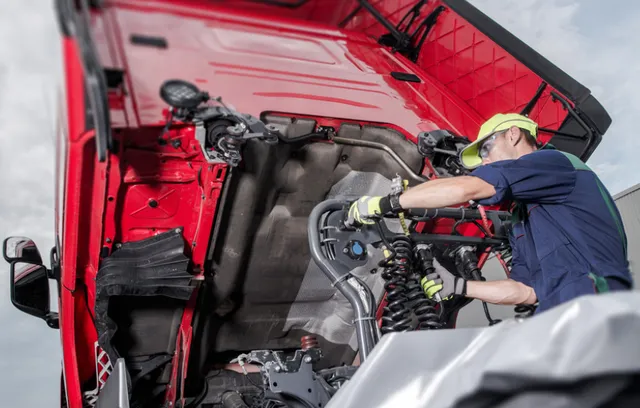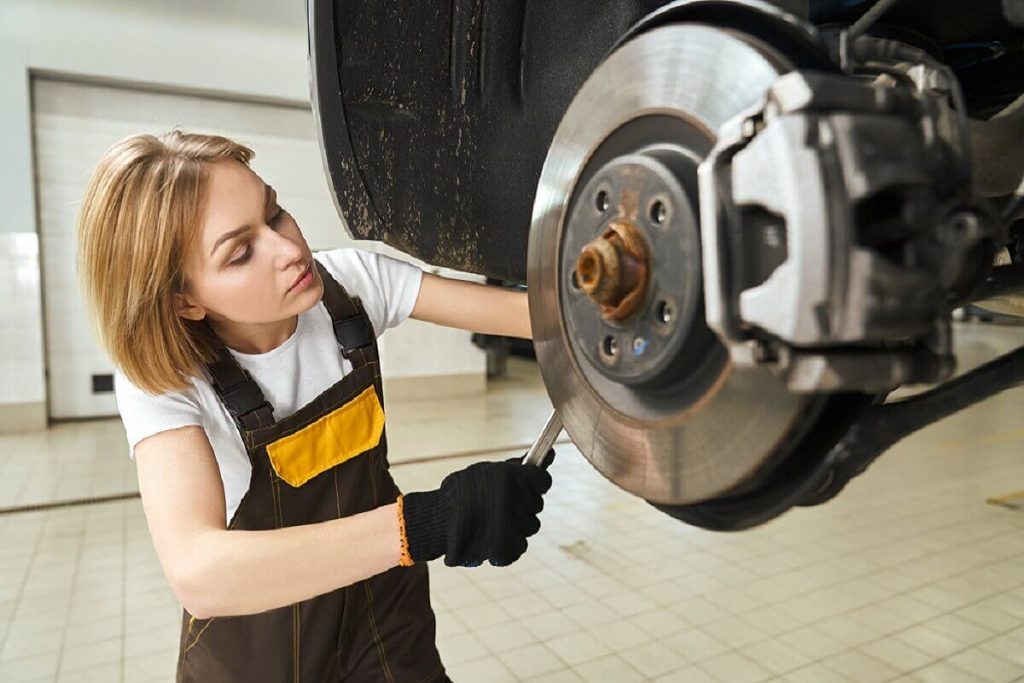It is not good if your truck brake pedal releases while the engine is running. You won’t be able to apply brakes effectively in such a situation, which is harmful for both you and your vehicle. When it comes to trucks, you can overlook many little flaws, but you should never overlook any brake-related problems. When the engine is running, you should be cautious if your brake pedal reaches the bottom. It might result in the braking function going away entirely!
Therefore, if you encounter something similar, you are not advised to continue driving your truck. But why does it happen, and how can you stop it? Let’s quickly review the potential reasons.
What is a Brake Pedal?
It is seen that the invention of the internal combustion engine, the production of tires from rubber materials and the development of the brake system have shaped the whole process. The brake pedal, one of the most important parts of the brake repair system in motor vehicles, initiates the braking action. In a straightforward definition, the chain of action required for the vehicle to slow down and stop begins with the driver pressing the brake pedal.
The system required for a motor vehicle to slow down and stop is called the braking system. Technically, the system that converts kinetic energy into heat energy with friction is extremely important for safe driving. The braking action has a close relationship with the wheels and the ground. According to the laws of physics, concepts such as deceleration acceleration, gravity, vehicle weight and applied force combine to affect the braking speed of the vehicle.
Why Does My Brake Pedal go to the Floor?
The most common reason why a brake pedal goes to floor is due to a brake fluid leak or air in the brake system. A faulty master brake cylinder or a bad booster can also cause it. A low brake fluid level can cause air in the brake system.
These causes are the most common reasons why this problem may occur. Here is a more detailed list of the common causes of why the brake pedal goes to floor when the engine is running or when starting the truck.
Brake Fluid Leak
The most common reason this happens is that you have a brake fluid leak somewhere on the brake system. This is often due to a rusty brake line, but it can also be due to problems with leaking seals at the calliper pistons. Brake fluid leaks are often very visible on the ground, so if you have seen a pool of fluid on the garage floor, it is time to check for any brake fluid leaks.
Pressing the brake pedal with a fluid leak will cause the brake fluid to pour out. When the brake pedal comes back up, it will suck in air through the leak, which will cause your brake pedal to be very swampy.
Faulty Master Brake Cylinder
Another common reason why your brake pedal goes to floor but no leaks when the engine is running is a bad master brake cylinder. The master brake cylinder is located behind the brake pedal on the other side of the engine bay’s firewall. The purpose of the master brake cylinder is to push brake fluid to the calliper pistons to reduce the vehicle’s speed. The master brake cylinder has a sealing around the pushing piston, and if that sealing starts to leak, the brake pressure will go back on the other side of the piston when you press the brake pedal.
This will cause your brake pedal to always lose pressure when you press it, and this will feel like a swampy or sinking brake pedal.
Faulty Brake Booster
Between the master brake cylinder and the brake pedal, you will find the brake booster. The brake booster uses a vacuum to increase the brakes’ power when you touch the brake pedal. If you have even driven a truck without a functional brake booster, you know how much pressure it requires without it.
If your brake pedal starts to build pressure very low down, but it feels very stiff once it gets there close to the bottom, you probably have an issue with your brake booster. It is uncommon for the brake booster to fail, but it happens on some truck models.
Air in the Brake System
Did you or someone else recently replace something in the truck hydraulic brake system without performing a proper brake bleeding afterwards? Then this may be your issue. Air is compressible, unlike brake pedal, and goes to floor, but fluid is full. Therefore, the brake system must be completely free from air to build pressure and avoid getting a swampy brake pedal quickly. The only way to remove air from the brake fluid system is to bleed it properly.
Low Brake Fluid Level
If you have a brake fluid level warning light on your dashboard, it is definitely time to check the brake fluid level. If the brake fluid level is low, air can come into the brake system when you are taking sharp turns, for example. In the previous section, I talked about what happens with your brake system when you have air inside of it. If your brake fluid is so low that air has come into the system, then insufficient fluid is left to refill it. You will have to bleed the brake system again.
Which Pedal is the Brake?
In a typical truck, the gas and brake pedals are on the far left when you’re sitting in the driver’s seat. It’s positioned to the left of the accelerator pedal (which controls the vehicle’s speed) and the clutch pedal (if the truck has a manual transmission). Pressing the brake pedal activates the vehicle’s braking system and slows down or stops the truck, depending on how much pressure you apply. It’s important to use clutch and brake pedal assembly to ensure safe and controlled stopping, especially when driving larger trucks or carrying heavy loads.
If your Brake Pedal Suddenly Sinks to the Floor?
There are several reasons explaining why your brake pedal goes to the floor.
1. Lack of Brake Fluid
A low brake fluid level in your brake fluid reservoir occurs either because of brake fluid leaks or natural attrition. If the brake fluid level remains low, it can cause a decrease in braking system pressure and cause your braking ability to diminish or disappear.
2. Brake System Leak
Unresponsive brakes or the ‘brake pedal goes to floor’ symptom is a possible indication of a leak in your braking system. With a leak, an incorrect amount of hydraulic fluid will flow through your brake system— hindering your braking ability. A brake system leak could stem from many sources.
For example, brake fluid leaks can occur at a brake hose or calliper. A leak in your calliper can decrease your system’s brake fluid and pressure. The pressure loss from a loose or damaged brake calliper seal can cause you to push the brake pedal down for it to work.
One obvious sign of a brake fluid leak is a small puddle of fluid underneath your parked truck. Another easy way to identify a fluid leak in your braking system is to check the brake fluid reservoir — if fluid levels have dropped below minimum, you have a problem.
3. Bad Master Cylinder
The master cylinder pumps brake fluid into each brake line. It may fail due to wear and tear. A failing brake master cylinder won’t allow your pipes to get the necessary brake fluid.
If you’re experiencing a spongy brake pedal, check if you’re dealing with worn-out master cylinder cup seals. Faulty cup seals result in a loss of hydraulic pressure, which can cause a fading pedal.
The pressure ensures there’s resistance when you press the brake pedal. Without that resistance, your brake pedal goes to the floor. As a result, your vehicle will inch ahead at stop lights.
4. Bad Brake Booster
Brake boosters are situated between your brake pedal and master brake cylinder, with a connection that extends to your engine. Your brake booster provides power to your braking system to engage your brakes.
With a failing booster, your brakes may not engage even when you push the pedal, causing either a soft or spongy pedal. There won’t be enough pressure for your disc brakes to clamp the brake pad on your brake rotor (or drum brakes to activate the wheel cylinder to push brake shoes against the brake drum.)
A brake booster usually becomes faulty due to age and wear. But, it could become worn out if you often slam on your brakes or drive in stop-and-go traffic. Replacing the booster is the only option once you identify a bad brake booster as the cause of your brake problem.
How to Fix a Soft Brake Pedal of Truck?
Choose Best Truck Repair Shop For Your Truck Today!
- Affordable
- Quick Fix
- Boost Truck Performance

Air in the brake line(s) is the most common cause of a soft/spongy brake pedal. Air entering the brake lines can prevent brake fluid from flowing properly, causing the brake pedal to feel spongy or soft.
If the brakes are soft or spongy, this is a good time to change or flush the brake fluid. Flushing the brake fluid, commonly called bleeding the brakes, gets rid of the air. (Bleeding the brakes uses fluid to push air out of the brake system.) Over time, brake fluid absorbs moisture. Flushing the brake fluid prevents old fluid from boiling, which can cause a low brake pedal. The clean, fresh fluid protects and preserves other brake components, such as the master cylinder and ABS (anti-lock brake system), for long, trouble-free operation.
Final Words
In conclusion, a brake pedal that goes to the floor when the engine is running is a matter of critical concern and demands immediate attention. It signifies a potential brake system malfunction that can jeopardize your safety and others on the road. Several factors could lead to this issue, including air in the brake lines, brake fluid leaks, worn-out brake pads, or a failing master cylinder. Ignoring these warning signs can have dire consequences, so addressing the problem promptly is crucial. Regular brake system maintenance, truck brake repair and inspections can help prevent such issues from occurring in the first place, ensuring that your brakes continue to function effectively providing the peace of mind you need while driving. Remember, when it comes to brake problems, safety should always be the top priority, and seeking professional assistance from B&S Truck repair is the best course of action to ensure your vehicle’s true brake are in optimal working.

